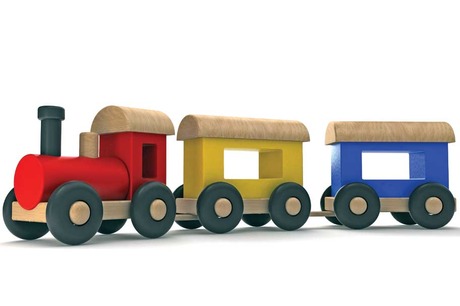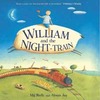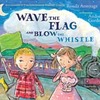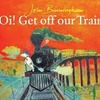many benefits, says Marianne Sargent.

This hugely popular theme is great inspiration for a large-scale project that will keep everyone busy for weeks. Introduce it by taking a close look at the various types of train, exploring their features and purposes, and asking the children to share their own experiences of rail travel. Then take a toy train set and help the children to create their own model railway based in the local area.
Large-scale project work has a great many benefits for the children, who develop skills in planning, problem solving and making decisions. What's more, this particular project involves working with wood to construct a permanent installation, as well as exploring various materials.
ALL ABOUT TRAINS
See Inside Trains and The Big Book of Big Trains from Usborne are helpful books for finding out about trains. Both are packed with detailed colour illustrations and interesting facts.
Adult role
- Share these books with the children.
- Point out how trains have changed over the years. Have any of the children been on a steam train? What did it feel like? How fast was it? Do they have any photographs they can bring in?
- Talk about how trains serve different purposes. Point out the freight trains. Can the children suggest what goods trains might carry? Explain that freight can also be transported by lorry. Can the children suggest why using a train might be a good idea?
- Invite the children to share their experiences of travelling on trains. Where did they go to catch the train? How did they buy their tickets? What did it feel like to travel on a modern passenger train? For those children who have experienced travel on a steam train, was it faster or slower?
For real
Visit a station or, ideally, a railway museum. The National Railway Museum in York is a fantastic free day out and provides key stage appropriate educational activities. Go to www.nrm.org.uk for more information.
Learning opportunities
CL: Expresses themselves effectively, showing awareness of listeners' needs.
L: Knows that information can be retrieved from books.
UW: Talks about why things happen and how things work.
MODEL RAILWAY
This project will take several weeks to complete. Work on it in stages with small groups of children.
Before starting the project
- Choose a suitable train story. Any of the books from the Little Red Train series by Benedict Blathwayt would be a good introduction for this activity. Busy Day is particularly useful, however, because it has a map of the Little Red Train's route inside, as well as a spotting activity featuring railway components.
- On a large flat piece of wood, draw out a rough map of the local area around your setting in pencil. Refer to an aerial photograph to help. Draw around wooden building blocks to indicate where various landmarks and buildings are situated (these blocks are going to be stuck on to the board later). Label these places in pencil.
Adult role
- Share Busy Day with the children. While reading, encourage the children to look out for railway components in each of the pictures.
- Look at the map at the front of the book. Point out landmarks and trace the possible routes the train could take. Flick to the back and look at the train's actual route.
- Show the children an aerial photograph of the local area. Point out landmarks such as shops, churches, community centres, libraries, playgrounds, train stations, canals, lakes, sports fields, schools, hospitals and the children's houses.
- Explain that you are going to make a model railway set for your local area. Show the children some photographs of model railways to give them an idea of what one looks like. Show them the board you have prepared as a base. Point out the various places and landmarks you have marked out in pencil.
- Invite a small group of children to place a wooden railway track on the board. Help them to think about how they can avoid the buildings you have marked out.
- When the track is in place, help the children to glue it down with wood glue. Leave it to set.
- Gather more groups of children and look again at the aerial photograph. Ask them to point out water, grassy, wooded and tarmac areas. Help the children locate these areas on the wooden board. Provide gravel, sand, green felt, blue cellophane and paint to recreate them.
- Show other children some photographs of local buildings. Invite them to choose which they would like to make. Help them to select appropriately sized wooden blocks to represent their buildings. Talk about the colours of each building, including the doors and roof. Use a pencil to draw out main features and provide paints for the children to paint their blocks.
- Use a permanent marker to draw details on the buildings including door and window frames, roof tiles and bricks. Then invite the children to stick them in the correct places on the board.
- To finish it off, invite some children to stick a few tree cuttings here and there to represent trees.
- Finally, get the train on the line and let the children play with it.
Learning opportunities
CL: Is able to follow directions; can listen and do for a short span.
PD: Handles construction objects with increasing control.
M: Shows an interest in shape through sustained construction activity or by talking about shapes or arrangements.
EAD: Explore a variety of materials, tools and techniques, experimenting with colour, design, texture, form and function.

SONGS, RHYMES, GAMES
Down at the station
Find an animated version of the rhyme Down at the Station on the BBC website at www.bbc.co.uk/schoolradio/subjects/earlylearning/nurserysongs/ A-E/down_at_the_station.
Trains are fantastic
Find a video of Barnaby Bear singing about steam trains on the BBC Learning Zone website, at www.bbc.co.uk/learningzone/clips/trains-are-fantastic/11185.html.
I went on a train ride
Play a train-themed version of the I Went to the Supermarket game, encouraging children to list things that they might see on a train journey. For example, 'I went on a train ride and saw ... another train, some train track, a signal, some sheep, a factory, a tunnel, a bridge.'
MORE IDEAS
- Make model trains out of small recycled cardboard packages and use buttons for wheels.
- Go on a train ride.
- Set up a role-play train station.
- Provide the children with banana boxes (or similar) from your local supermarket along with some string to make a train in the outdoor area.
- Play counting games using a model train by adding and taking away carriages.
MODEL RAILWAY RESOURCES
A large space where the project can sit and be added to, plain unvarnished wooden building bricks, toy wooden train and track (try to find these as second-hand toys in a charity shop, car boot sale or on eBay), large off-cut of plywood or MDF to use as a base, wood glue, permanent markers, poster paint, PVA glue, sand, gravel, green felt, blue cellophane, cuttings from trees, aerial photograph of the local area surrounding your early years setting (find this on Google Maps), and photographs of local buildings and landmarks.
Books
The rhythmical sound and movement of trains make them a favourite subject for picture books, of which there are plenty to choose from.
- And the Train Goes ... by William Bee - beautifully illustrated and a joy to read out loud.
- William and the Night Train by Mij Kelly and Alison Jay - lovely picture book to read at the end of the day.
 Wave the Flag and Blow the Whistle by Ronda Armitage and Andrew Gordon - two children and their grandparents go on a day trip by train.
Wave the Flag and Blow the Whistle by Ronda Armitage and Andrew Gordon - two children and their grandparents go on a day trip by train.- Freight Train and Inside Freight Train by Donald Crews - the simple sentences in these books are quickly memorised and recited by the children. A popular read.
- Oi! Get off Our Train by John Burningham - a little boy sets off on a train journey and is joined by all kinds of endangered animals.
 Thomas the Tank Engine by Rev W Awdry - this series offers a great selection to choose from.
Thomas the Tank Engine by Rev W Awdry - this series offers a great selection to choose from.- Terrific Trains by Tony Mitton and Ant Parker - information book with rhythmical rhyming text.
Marianne Sargent is a writer specialising in early years education and a former foundation stage teacher and primary and early years lecturer









